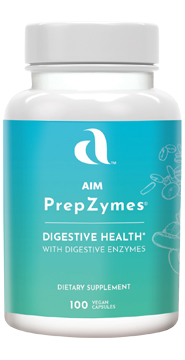AIM PrepZymes ™
Benefits
Digestive problems comprise the number one health problem in North America. These concerns, encompassing everything from hemorrhoids to colon cancer, result in more time lost—at work, school, and play—than any other health problem. They also appear to be occurring with much more frequency—while many of them were almost unheard of in our grandparents’ times, they are cropping up more and more and at an earlier and earlier age. One way to help maintain digestive health is to be sure you get enough food and digestive enzymes. Enzymes are an important part of the living well equation. Enzymes Three Types Digestive enzymes are secreted by the pancreas and break down foods, allowing their nutrients to be absorbed into the bloodstream and used in body functions. They ensure that we get the greatest possible nutritional value from foods. Digestive enzymes include protease, which digests protein; amylase, which digests carbohydrates; lipase, which digests fats and oils; and maltase, which digests malt sugars and grains. Food enzymes are enzymes supplied to us through the foods we eat. They include digestive enzymes, but also enzymes unique to the particular foods. Food enzymes help us "predigest" foods; that is, start breaking down foods before our bodies’ enzymes begin to do so. According to Santillo, the enzymes found in raw foods digest 5 to 75 percent of the foods themselves without the help of other enzymes. This way, our bodies’ digestive enzymes have help in the digestive process, and we do not use as many of the body’s "in-house" enzymes. The importance of enzymes In the enzyme nutrition axiom, Howell postulates that "The length of life is inversely proportional to the rate of exhaustion of the enzyme potential of an organism. The increased use of food enzymes promotes a decreased rate of exhaustion of the enzyme potential." In other words, the more enzymes you get, the longer and healthier you live. The key is to remember that food enzymes are destroyed at temperatures above 118 °F. This means that cooked and processed foods contain few, if any, enzymes, and that the typical diet found in industrialized countries is enzyme-deficient. When we eat cooked and processed foods, we could well be eating for a shorter and less-than-healthy life. This points back to the importance of eating raw fruits and vegetables because they are "live foods"; that is, foods in which the enzymes are active. The more enzymes you get, the healthier you are. And the more raw foods you eat, the more enzymes you get. The benefits of enzymes Digestive enzymes help us digest foods more completely. This means more nutrients (and maybe eating less!) and the good health that goes with them. There is another advantage to being sure that foods are well-digested. When foods are not well-digested, they remain in the stomach and can rot and putrefy. This results in a buildup of waste in the colon. This fecal matter begins to decay, producing bacteria and toxins. The toxins eventually seep through the bowel wall, where blood capillaries pick them up and distribute them throughout the body. This can result in health problems. These problems include constipation, stomach bloat, poor digestion, gas, fatigue, weight gain and weight loss, headaches, and more. Using digestive enzymes ensures that your foods are more completely digested, helping to eliminate potential problems due to toxins. AIM PrepZymes ™
Each capsule of AIM PrepZymes™ contains enzymes to help you digest the foods you eat, plus two special features. The enzymes are
Special Features Cultured enzymes have a very wide work environment: from 2.0 to 12.0 pH. In other words, they are active in both acidic and alkaline environments. This makes them the best possible choice for predigestion. Papaya leaf and alpine garlic When you combine cultured enzymes with papaya and alpine wild garlic, you get the best possible digestive product: one that provides you with important digestive enzymes, as well as the materials to fight metabolic damage. Enhanced Digestion The lipase found in AIM PrepZymes ™ ensures that fats and oils are properly broken down early in the digestive process. This eliminates the possibilities of proteins becoming coated with oil, which means they may escape predigestive action. The sucrase and maltase address the high amounts of "hidden" sugars found in processed foods and snack foods high in dairy, malt, and white sugars. Try this Prepare a bowl of oatmeal, and let it sit overnight. Then mix into the oatmeal the ingredients of one capsule of AIM PrepZymes ™. Within 15 minutes, you will notice that the oatmeal becomes more "liquid." Within one hour, you will practically be able to drink it! This is the action of the enzymes breaking down the oatmeal. This is what AIM PrepZymes™ does for the foods you eat! How to use AIM PrepZymes ™
Q & A May children and pregnant women use AIM PrepZymes ™? Is there anyone who should not take AIM PrepZymes ™? If we take enzymes orally, aren't they distroyed by the stomach acid before they do anything ? Santillo also notes that foods are predigested by enzymes in the upper portion of the stomach, which is known as the cardiac stomach. According to Gray’s Anatomy, "The cardiac portion of the stomach is a food reservoir in which salivary digestion continues. The pyloric [lower stomach] portion is the seat of active gastric digestion." What is the source of the enzymes found in AIM PrepZymes ™? How many active units does each enzyme have ? May I take AIM PrepZymes ™ with AIM FloraFood ™? May I take AIM PrepZymes ™ with other AIM products? Suggested Reading Santillo, Humbart, B.S., M.H. Food Enzymes: The
Missing Link to Radiant Health. Prescott Valley, AZ: Hohm Press,
1987.
|
Hong Kong United Kingdom Other |
Loren & Kathleen Schiele
8733 Fawn Drive
Dallas, TX 75238
Phone: 214-340-0379 or Call Toll Free: 877-735-2121
email: Loren@YourLifeSource.com
Serving You via the Internet since 1996
Copyright © 2013 Loren & Kathleen Schiele -- All Rights Reserved
.